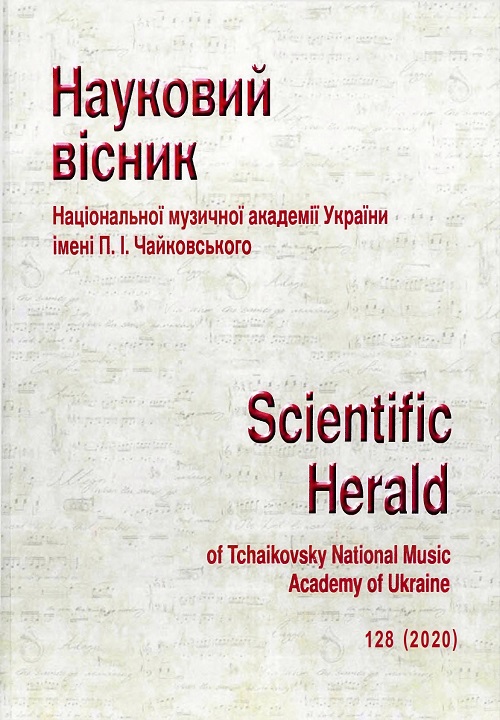“Distant Bells” by Phank Kok Jun: Chamber-Instrumental Version of the Dialogue between Chinese and European Traditions
DOI:
https://doi.org/10.31318/2522-4190.2020.128.215204Keywords:
daruan, concert for traditional instruments, music by Phank Kok Jun, chamberinstrumental works by Chinese composers, ensemble performanceAbstract
Relevance of study. There are considered the features of the chamber-instrumental version of the Concerto for daruan and the orchestra of traditional instruments “Distant Bells” by contemporary Chinese composer Phank Kok Jun. The relevance of the topic caused by extending interest of musicologists in the issues of the interaction between eastern and western musical traditions in both composer and performing aspects.
Main Objective. The purpose of the article is to reveal the specifics of the chamberinstrumental version of “Distant Bells” for daruan with piano, cello and percussion by Phank Kok Jun as a reflection of the dialogue between European and Chinese musical traditions.
Methodology. The research methodology is based on the method of genre attribution used to clarify the genre nature of “Distant Bells”; historical-typological approach — for understanding the place of the work among other concert opuses of Chinese composers; the method of structural analysis to determine the form of the work; the method of semantic analysis to determine the correspondence of the program to the musical events of the piece and the method of stylistic analysis to determine the intro and extra-stylistic components of musical vocabulary.
Results/Finding and Conclusions. It is established that this opus is an alternative interpretation of the concert created for the ensemble of daruan with piano, cello and percussion, which has gained great popularity among performers. It was revealed that when orchestral parts are translated to the timbres of the soloing Chinese instrument and European duet of piano and cello, a peculiar dialogue between Western and Eastern musical traditions arises. Such a timbre-acoustic connection makes adjustments to the genre and compositional profile of the work. As a result, the genre modus of “concerto” is reinforced in numerous solo episodes, cadences, improvisations. The compositional structure of the concert’s sections is influenced by national musical frame’s types, usually based on the variant development of theme connected with eastern improvisational tradition. The palette of stylistic features and linguistic means combines modal, metro-rhythmic, timbre features of Chinese and European music. It has been established that it is instrumental reorientation that brings allusions of “Western” origin, supporting the dialogue with the Chinese stylistic and significantly expand the semantic horizons of the work
Downloads
References
Makushin, V. V. (2010), Modern trends in chamber ensemble music [Sovremennye tendencii v kamerno-ansamblevoj muzyke]. Vestnik Cheljabinskogo gosudarstvennogo universiteta. [Bulletin of Chelyabinsk State University]. No. 11 (192). Philology. Art criticism. Vol. 42, рp. 161– 165 [in Russian].
Polskaja, I. I. (2001), Chamber ensemble: history, theory, aesthetics [Kamernyj ansambl’: istorija, teorija, jestetika]. Kharkiv State Academy of Culture. Kharkov, 390 p. [in Russian].
Polskaja, I. I. (2017), Historical modes of the chamber ensemble in the mirror of musical hermeneutics [Istoricheskie modusy kamernogo ansamblja v zerkale muzykal’noj germenevtiki]. Culture of Ukraine [Kultura Ukrainy]. Vol. 57, рр. 119–128 [in Russian].
Peng, Cheng. (2011), Ladova system of Chinese music and its implementation in the works of composers of the twentieth century [Ladovaja sistema kitajskoj muzyki i ejo pretvorenie v tvorchestve kompozitorov XX veka]. The dissertation author’s abstract for gaining the degree of the Candidate of Art Criticism by specialty 17.00.02 Music Art. Glinka Nizhny Novgorod State Conservatoire. Nizhny Novgorod, 22 p. [in Russian].
Samoilenko, O. I. (2003), Genre nature of the instrumental concert and concert work of A. Eshpay [Zhanrovaya priroda instrumental’nogo kontserta i kontsertnoe tvorchestvo A. Eshpaya], The dissertation author’s abstract for gaining the degree of the Candidate of Art Criticism by specialty 17.00.03 Music Art. Gnesins Russian Academy of Music. Moscow, 26 p. [in Russian].
Xin, Xin. (2018), Some questions about the specifics of musical form in Chinese traditional music [Nekotorye voprosy specifiki muzykal’noj formy v kitajskoj tradicionnoj muzyke]. Culture and Arts Herald [Vestnik kul’tury i iskusstv]. Chelyabinsk State Academy of Culture and Arts. No. 4 (56), рр. 133–137 [in Russian].
Su, Yucheng. (2017), About translating program into a concert of Zhao Jiping for cello with the Chinese traditional orchestra “Song Zhuang Zhou” [O pretvorenii programmnosti v koncerte Chzhao Czipina dlja violoncheli s kitajs’kim tradicionnym orkestrom «Son Chzhuan Chzhou»]. South-Russian Musical Anthology. [Iuzhno-Rossiiskii Muzykal’nyi Al’manakh]. Rostov State Rachmaninov Conservatory. Issue 1, рp. 27–32 [in Russian].
Chaykin, S. G. (2008), The specificity of the expressive means of piano in ensemble music [Specifika vyrazitel’nyh sredstv fortepiano v ansamblevoj muzyke]. The dissertation author’s abstract for gaining the degree of the Candidate of Art Criticism by specialty 17.00.02 Music Art. M. I. Glinka Novosibirsk State Conservatory. Novosibirsk, 23 p. [in Russian].
Phang Kok, Jun. (2020). Available at: https://www.phangkokjun.com/about (accessed: 05.05.2020) [in English].
饶思铭 — 大阮 — 钟声随想 [Jonathan Rao — Daruan — Distant Bells] (2020), available at: https://www.youtube.com/watch?v=rKhp6iriQAo (accessed: 05.05.2020) [in Chinese].
Downloads
Published
How to Cite
Issue
Section
License
Our journal abides by the CREATIVE COMMONS copyright rights and permissions for open access journals.
Authors, who are published in this journal, agree to the following conditions:
The authors reserve the right to authorship of the work and pass the first publication right of this work to the journal under the terms of a Creative Commons Attribution License, which allows others to freely distribute the published research with the obligatory reference to the authors of the original work and the first publication of the work in this journal.
The authors have the right to conclude separate supplement agreements that relate to non-exclusive work distribution in the form in which it has been published by the journal (for example, to upload the work to the online storage of the journal or publish it as part of a monograph), provided that the reference to the first publication of the work in this journal is included.




